 The advantage of such determinant tomato varieties as Dina is its compact growth, which is combined with a fairly high yield. But how to achieve good results?
The advantage of such determinant tomato varieties as Dina is its compact growth, which is combined with a fairly high yield. But how to achieve good results?
The answer can only be found by reading the characteristics and description of the variety.
Content
Description of tomatoes "Dina"
If the tomato variety has the “determinant” characteristic, this means that the bushes have limited growth and do not require pinching the tip of the stem. The average growth of Dina tomato bushes is between 50 cm and 1 m. Bushes require formation, the best results can be achieved by forcing the bush in 3-4 stems. Bushes form medium-sized leaves. In one inflorescence, up to 4-5 flowers are formed. The first of the inflorescences appear after 6 or 7 leaves, the rest are formed after each pair of leaves. Tomatoes "Dina" belong to mid-early varieties, as the first tomatoes appear 110-115 days after sowing.
The fruits of Dina tomatoes are distinguished by their saturated orange color, average weight from 100 to 150 g. About 4-5 small seed chambers are formed inside the fruit. The fruit pulp is juicy, rich in vitamins and minerals. In addition, the sufficient density of the tomato allows them to tolerate long transport, and also stored for a certain time before use. Productivity from 1 bush is about 4-5 kg.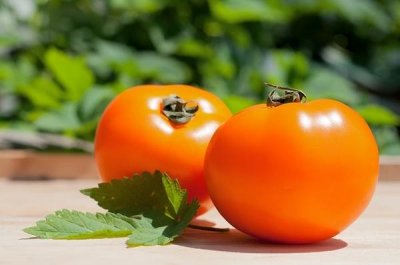
Tomatoes "Dina" take root both in greenhouses and open ground, zoned for almost all regions of Russia in the middle and southern latitudes. The variety has gained distribution in other post-Soviet countries, including in Ukraine, Belarus, Moldova. Tomatoes "Dina" are officially listed in the register of vegetable varieties of the Russian Federation.
The main advantages and disadvantages of the variety
The valuable characteristics of the Dina variety, which gardeners relate to its merits, include:
- average maturity dates allow it to ripen in the Russian climate;
- tomatoes have an original color, including due to the high content of carotene;
- medium-sized fruits, smooth, with a shiny skin, have an excellent presentation;
- fruits are transportable and resistant to physical damage;
- the variety is high-yielding.
The disadvantages of Dina tomatoes include poor resistance to late blight and watery rot. At the same time, these shortcomings are quite easily compensated by compliance with agricultural technology and preventive treatments.
Agrotechnology of tomatoes "Dina"
Caring for tomatoes is not particularly difficult, however, it requires rigor in meeting all technological requirements. The main blocks of measures for growing tomatoes are to prepare a place for planting, treat seeds, prepare an earthen mixture for seedlings, care for seedlings and plant them in the ground. Next - care before harvesting.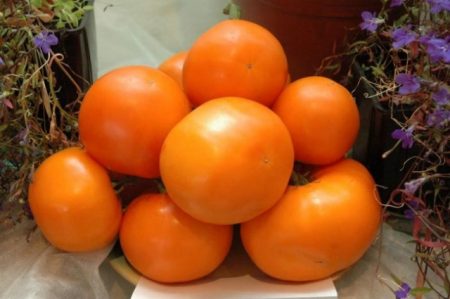
Preparing the landing site
This issue is especially acute in small gardens and household plots, where it is difficult to comply with all principles of crop rotation. It has long been known that tomatoes are not recommended to plant after growing potatoes, peppers, zucchini, and eggplant. At the same time, tomatoes show good results if their predecessors were cereals, legumes, root crops, cucumbers, cabbage and other vegetables not related to nightshade.
Nevertheless, even in small areas you can get out if you use the following trick. At the end of the season, when the crop is harvested, the site is dug up or plowed, after which they are sown with green manure - grasses or grains, the green mass of which is subsequently used as a green fertilizer. In winter, the grown mass of herbs is plowed up. Thus, the soil is fertilized, and the tomatoes get the right predecessor.
If everything is normal with crop rotation, it is better to introduce humus, chicken droppings, compost from weeds and other organic components (sawdust, peel of vegetables, etc.) into the ground. Compost preparation can be accelerated by preparations of the Baikal type, the principle of which is based on the action of beneficial microorganisms that accelerate the over-heating of organics.
In addition, the site for the future tomato plantation should be lit, have sufficient air access, as well as an irrigation source.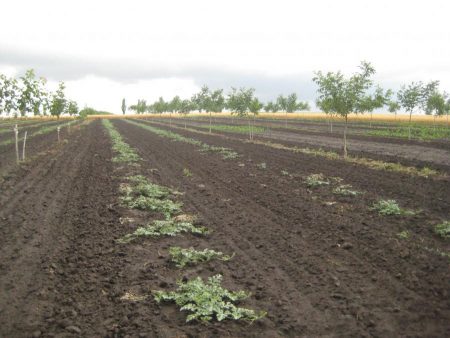
Seed treatment
An equally significant seed treatment procedure, thanks to which disease prevention is carried out at the seedling stage, the immunity of future plants is laid and energy is accumulated for good germination. At this stage, the seeds are disinfected and treated with a growth stimulant.
Disinfection is a seed disinfection procedure. The most common remedy for this is a potassium permanganate solution containing 2% of the active substance, in which the seeds are soaked for 20-30 minutes. A more advanced treatment involves soaking in a fungicide solution. The ideal drug for such purposes is Agat-25, which is endowed not only with a fungicidal property, but also stimulates seed germination. That is, at the output we have a treatment of type 2 to 1. Agat-25 working solution is prepared at the rate of 7 g per liter of water, which is enough to process half a kilo of seeds.
In addition, a drug such as Zircon is recommended from tomato growth stimulants. Only 2 drops of Zircon per 0.1 l of water allow you to prepare a working solution in which the seeds are soaked for 3 to 6 hours. After treatment with a growth stimulant, the seeds are not washed, but only carefully dried on the windowsill.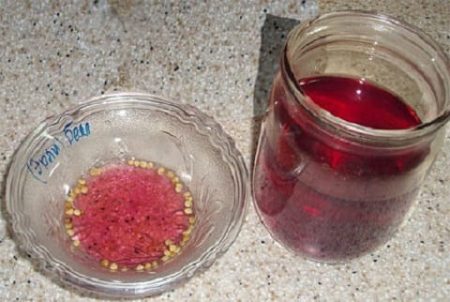
Preparation of earthen mixture for seedlings
Of the many recipes for mixing components for tomato seedlings, the following is proposed. Peat, turf soil, humus and sawdust scalded with boiling water are mixed in equal parts. On 10 l of such a mixture add one and a half glasses of wood ash, 3 tablespoons of superphosphate, 2 tablespoons of potassium sulfate, a tablespoon of urea.
The soil is also subject to mandatory disinfection, because in its components there will probably be larvae and spores of pests. Distinguish between thermal and chemical processing methods, namely:
- Freezing. The prepared mixture is kept in the cold for 5 days. Then they do a little trick by placing soil bags in a warm room in which pests awaken. They are kept warm for 1-2 days and then taken out again in the cold. This cycle is repeated several times within a month or two.
- Calcination. Bags with soil for 30 minutes are placed in the oven at a temperature of up to 90 ºС.
- Steaming Bags with soil for 30-40 minutes are kept in a steam bath. The bag should be small so that the soil has time to get steam.
- Fungicide treatment. The soil is treated with a working solution of any fungicide for tomatoes: Quadris, Ridomil, the same Agate, which stimulate seed growth.
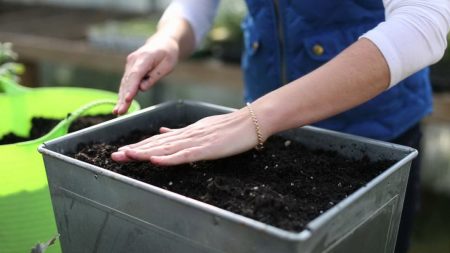
Sowing seeds
The soil for seedlings is laid out in pots. Immediately before sowing, the soil is loosened, watered with warm water. The seed sowing depth should not exceed 2 cm, otherwise the seeds run the risk of not germinating. Sown pots are covered with foil to speed up germination.
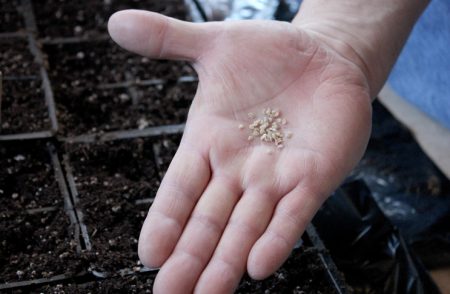
Seedling Care
The first shoots appear in 7-10 days. It is important not to allow the soil to dry out and water it in a timely manner. Seedlings can be fed with a solution of superphosphate (4 g per bucket of water), which will strengthen the root and immune systems of seedlings. Sprouts dive after the appearance of the second leaf, distributing them among different containers and slightly increasing the depth of their planting.
It is recommended to extend daylight hours by equipping a room with seedlings with fluorescent lamps. Two weeks before transplanting, seedlings begin to harden, taking out pots with seedlings to a balcony or fresh air. Seedlings are tempered, ranging from half an hour to several hours.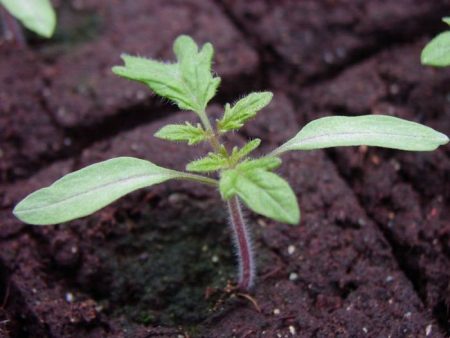
Outdoor planting and seedling care
Based on the local climate, tomato seedlings Dina are planted in the second half of May - the first half of June. The site is pre-cleaned of weed grass, loosen. The scheme of planting seedlings 40x60 cm, it is recommended to dig holes in a checkerboard pattern to rationalize the use of the area.
The depth of the holes should be about 12 cm. A glass of humus or ash is poured into each hole, watered with warm water, a seedling is planted and buried with earth. The area around the bush is mulched with sawdust.
After 2 weeks, when the seedlings take root, they begin to form bushes. It is best to leave 3-4 stems on the bush, removing weak shoots, as well as leaves in the lower part of the leaf, which formed below the level of the first ovaries.
Bushes are watered a couple of times a week, reducing the amount of watering in case of rain or cold weather. Feeding with mullein infusions is carried out twice. The solution is prepared in a ratio of 1:10 and insisted for 3-5 days, then poured into the aisle at the rate of 1 bucket per square meter. As necessary, weeding the beds.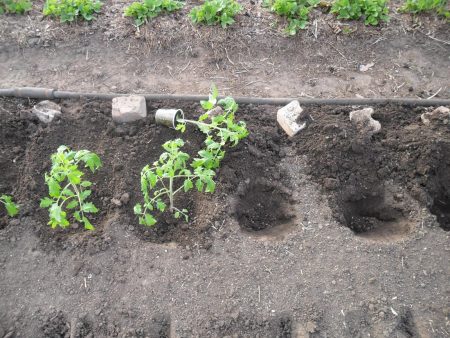
Diseases and Pests
In general, the Dina variety is resistant to tomato diseases, however, it is sensitive to late blight and watery rot. Against late blight, it is necessary to treat the bushes with the preparations Quadris, Ridomil, having prepared working solutions according to the instructions. Kvdaris effectively stops the spread of the disease, while Ridomil allows you to fix the result. An effective drug against watery rot is a solution of Bordeaux fluid, which is sprayed with bushes.
From the Colorado potato beetle, spider mite, aphids, such preparations as Confidor Maxi, Proteus and others will help.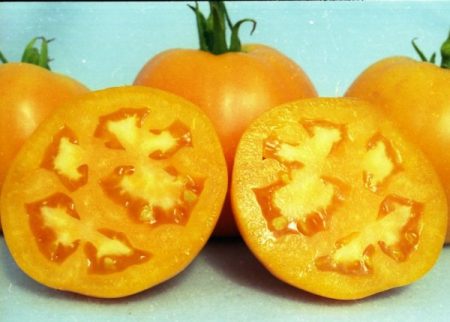
findings
Tomatoes "Dina" is a productive variety, the characteristics of which guarantee its popularity not only among gardeners, but also among farmers, because it is well stored, transported, and the taste of a tomato makes the variety popular among consumers.
Reviews
Marina, Saratov
I’ve been growing Dean tomatoes for several years in a row. At the same time, I tried to plant both in the open ground and in the greenhouse. Empirically established that the yield in the greenhouse is higher, reaches 5-6 kg per bush. Despite the slight growth, the bushes should be tied up, otherwise they will get late blight.
Victoria, Tver
In the agricultural technology of the Dina variety, it is very important to carry out timely top dressing. To form the root system when planting seedlings, I pour 5 g of ammophos into the pit. Before flowering, I spill the beds with a compost solution (1 part of compost to 9 parts of water). When the ovaries have formed, I pour a solution of 4-5 g of potassium superphosphate into a bucket of water.




 Low-growing tomatoes, without pinching: 5 of the most delicious varieties
Low-growing tomatoes, without pinching: 5 of the most delicious varieties Why tomato seedlings grow poorly
Why tomato seedlings grow poorly We grow a tomato in a shell
We grow a tomato in a shell Growing tomatoes without watering according to the method of Kazarin
Growing tomatoes without watering according to the method of Kazarin